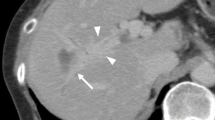Abstract
Purpose
This study aimed to reveal characteristic imaging features of bile duct adenoma (BDA) by radiologic–pathologic correlation.
Materials and methods
We retrospectively analyzed pathological and imaging findings of seven patients with BDA.
Results
The median maximum diameter of BDA was 5.5 mm. Six lesions had hemispheric morphology. Seven lesions were located in the liver subcapsular region, and proliferation of bile ductules without atypia and fibrous stroma was observed. Two lesions had different microscopic findings. In both lesions, proliferation of bile ductules without atypia was observed in the margin. In one lesion, the percentage of fibrosis and hyalinization was higher at the center than at the margin. In the other lesion, inflammatory cell infiltration was observed in the center. On contrast-enhanced imaging, BDAs showed hypervascularity in the early phase and prolonged enhancement in the delayed phase. On contrast-enhanced multidetector computed tomography during hepatic arteriography, two lesions showed ring-like enhancement in the first phase and prolonged enhancement in the second phase. These were the different histopathologic features of BDAs between the margin and center.
Conclusion
Bile duct adenoma can be characterized as a small semicircular lesion located in the liver subcapsular region, which show hypervascularity in the early phase with prolonged enhancement.




Similar content being viewed by others
References
Allaire GS, Rabin L, Ishak KG, Sesterhenn IS. Bile duct adenoma. A study of 152 cases. Am J Surg Pathol. 1988;12:708–15.
Aishima S, Tanaka Y, Kubo Y, Shirabe K, Maehara Y, Oda Y. Bile duct adenoma and von Meyenburg complex-like duct arising in hepatitis and cirrhosis: pathogenesis and historical characteristics. Pathol Int. 2014;64:551–9.
Pujals A, Amaddeo G, Castain C, Bioulac-Sage P, Compagnon P, Zucmann-Rossi J, et al. Author information BRAF V600E mutations in bile duct adenomas. Hepatology. 2015;61:403–5.
Hasebe T, Sakamoto M, Mukai K, Kawano N, Konishi M, Ryu M, et al. Cholangiocarcinoma arising in bile duct adenoma with focal area of bile duct hamartoma. Virchows Arch. 1995;426:209–13.
Pinho AC, Melo RB, Oliveira M, Almeida M, Lopes J, Graca L, et al. Adenoma-carcinoma sequence in intrahepatic cholangiocarcinoma. Int J Surg Case Rep. 2012;3:131–3.
Watanabe M, Shiozawa K, Ikehara T, Ichimori M, Shinohara M, Kikuchi Y, et al. Ultrasonography of intrahepatic bile duct adenoma with renal cell carcinoma: correlation with pathology. J Med Ultrason. 2013;40:251–6.
Takumi K, Fukukura Y, Nagasato K, Nakajo M, Natsugoe S, Higashi M. Intrahepatic bile duct adenoma mimicking hepatic metastasis: case report and review of the literature. Magn Reson Med Sci. 2013;12:141–5.
An C, Park S, Choi YJ. Diffusion-weighted MRI in intra hepatic bile duct adenoma arising from the cirrhotic liver. Korean J Radiol. 2013;14:769–75.
Tajima T, Honda H, Kuroiwa T, Yoshimitsu K, Irie H, Aibe T, et al. Radiologic features of intrahepatic bile duct adenoma: a look at the surface of the liver. J Comput Assist Tomogr. 1999;23:690–5.
Chuy JA, Garg I, Graham RP, VanBuren WM, Venkatesh SK. Imaging features of bile duct adenoma: case series and review of literature. Diagn Interv Radiol. 2018;24(5):249–54.
Song KD, Jeong WK. Benign nodules mimicking hepatocellular carcinoma on gadoxetic acid-enhanced liver MRI. Clin Mol Hepatol. 2015;21:187–91.
Maeda E, Uozumi K, Kato N, Akahane M, Inoh S, Inoue Y, Beck Y, et al. Magnetic resonance findings of bile duct adenoma with calcification. Radiat Med. 2006;24:459–62.
Ahn JM, Paik YH, Lee JH, Cho JY, Sohn W, Gwak GY, et al. Intrahepatic bile duct adenoma in a patient with chronic hepatitis B accompanied by elevation of alpha-fetoprotein. Clin Mol Hepatol. 2015;21:393–7.
Chen L, Xu MY, Chen F. Bile duct adenoma: a case report and literature review. World J Surg Oncol. 2014;26(12):125.
Wei J, Zhang D, Yang J, Xu C. Intrahepatic bile duct adenoma (peribiliary grand hemartoma): a case report and review of literature. Int J Clin Exp Pathol. 2015;8:5908–13.
Sica GT, Ji H, Ros PR. Computed tomography and magnetic resonance imaging of hepatic metastases. AJR Am J Roentgenol. 2000;174(3):691–8.
Valls C, Gumà A, Puig I, Sanchez A, Andía E, Serrano T, et al. Intrahepatic peripheral cholangiocarcinoma: CT evaluation. Abdom Imaging. 2000;25(5):490–6.
Fukukura Y, Hamanoue M, Fujiyoshi F, Sasaki M, Haruta K, Inoue H, et al. Cholangiolocellular carcinoma of the liver: CT and MR findings. J Comput Assist Tomogr. 2000;24(5):809–12.
Kim SH, Lee WJ, Lim HK, Park CK. Sclerosing hepatic carcinoma: helical CT features. Abdom Imaging. 2007;32(6):725–9.
Yoshikawa J, Matsui O, Kadoya M, Gabata T, Arai K, Takashima A. Dalayed enhancement of fibrotic areas in hepatic masses: CT-pathologic correlation. J Comput Assist Tomogr. 1992;16(2):206–11.
Funding
This study has not been funded by any company.
Author information
Authors and Affiliations
Corresponding author
Ethics declarations
Conflict of interest
The authors indicate no conflicts of interest.
Ethical approval
This study has been approved by the research ethics committee of Sapporo Kosei General Hospital.
Additional information
Publisher's Note
Springer Nature remains neutral with regard to jurisdictional claims in published maps and institutional affiliations.
About this article
Cite this article
Tatsumi, R., Ichihara, S., Suii, H. et al. Bile duct adenoma: imaging features and radiologic–pathologic correlation. Jpn J Radiol 38, 561–571 (2020). https://doi.org/10.1007/s11604-020-00938-0
Received:
Accepted:
Published:
Issue Date:
DOI: https://doi.org/10.1007/s11604-020-00938-0




